|
|
Post by codystarbuck on Oct 10, 2022 20:36:53 GMT -5
See, I don't find it that disproportionate. It is more in keeping with the strongman physiques of the early 20th century that inspired the look of Superman and others. They tended to have barrel chests and less developed legs, until more modern things like steroids started factoring into bodybuilding and weightlifting, allowing them to workout more and concentrate more on peripheral areas. It's also in keeping with things like the Fleischer Superman and the Batman TAS designs. But, that's why some people like chocolate ice cream and some weirdos eat sherbet.  |
|
|
|
Post by berkley on Oct 10, 2022 21:07:23 GMT -5
My impressions of those early-20th century strongmen don't agree with yours but regardless, I would have thought it more appropriate to emulate the description of Doc Savage in the early novels which explicitly state that he wasn't over-heavily muscled and was instead proportioned more like the Apollo Belvedere, if I remember.
I'd like to blame the artist, but knowing how detailed Moore's scripts usually are, I wouldn't be surprised if the artist was simply following Moore's instructions.
|
|
|
|
Post by codystarbuck on Oct 10, 2022 22:53:53 GMT -5
Well, he was growing older inside a chamber with increased pressure; so, I can see where you'd have him thicker in the chest and shoulders.
Regardless, I like Chris Sprouse's work; always have and I find that even the exaggeration works in his style, as he is dynamic and expressive, which helps bring these stories alive, for me.
Now, Sprouse isn't the only artist on these issues, which is another reason to give them a try. He mostly handles the present aspect of the stories; but, many issues include a segment set in the past and various guest artists come in for those, including Alan Weiss, Art Adams, Howard Chaykin, Jerry Ordway, Dave Gibbons, Gary Frank, Paul Chadwick, Gary Gianni, Russ heath, Kyle baker, and Hilary Barta.
|
|
|
|
Post by berkley on Oct 11, 2022 1:31:42 GMT -5
But I imagine all those other artists tried to stick to the established look of the title character? Something I'd usually applaud, but in this case, in my inconsistent and (apparently) hypocritical way, I wish they hadn't done.
Anyway, I should make it clear, in case it wasn't already, that I<m aware that this is more a matter of my own personal aesthetics than of the work itself - though I do think there's a case to be made for my POV of the question even at a semi-objective level.
Knowing Moore, the name 'Tom Strong' wasn't chosen by accident: IOW, the character was in some respects meant to embody the concept of strength. And since it's a male character, specifically a certain image of male strength - the 'Tom' probably isn't a coincidence either. But the imagery of that idea has changed pretty significantly over the years and varies from one person to another. Mine seems still largely determined by athletics (e.g. boxing, amateur wrestling) rather than body-building and by ancient Greco-Roman sculpture and engravings derived therefrom rather than the superhero comics (I mean those of the last few decades: I find the superhero imagery of Buscema, Colan, even Kirby, in a more impressionistic way, is in th same spirit).
Without looking up any online samples to confirm or deny, I remember Sprouse as going for some of that - for example, I think he gave Tom Strong big hands, and thick forearms and wrists compared to the usual modern superhero; and he avoided the "shredded" look expected of superheroes where every tiny muscle is shown - even through their clothing! But for some reason he couldn't get over the idea that the upper body had to be exaggerated, and grossly so, to my eyes.
|
|
|
|
Post by codystarbuck on Oct 15, 2022 18:02:02 GMT -5
Tom Strong #2 Nice Popular Science homage there! (Well, that type of magazine....) I think I saw this movie..... See chameleon Lying there, in the sun All things to Everyone Run, runaway.......... Creative Team: Alan Moore-writer, Chris Sprouse-pencils, Al Gordon-inks, Todd Klein-letters, Tad Ehrlich-colors, Scott Dunbier-editor Synopsis: In 1987, Ripley....I mean Tom Strong, is crawling through an access tunnel, hunting for a relentless killing machine.....  King Soloman destroys the last of the things with a nine-iron. They are some kind of mechanical device that could combine into something more intelligent and powerful. They cannot leave one intact. After King Solomon whomps it with his club, it looks like the danger is over. Cut ahead to 1999, and two boys are busy tinkering with a mechanical device they found..... 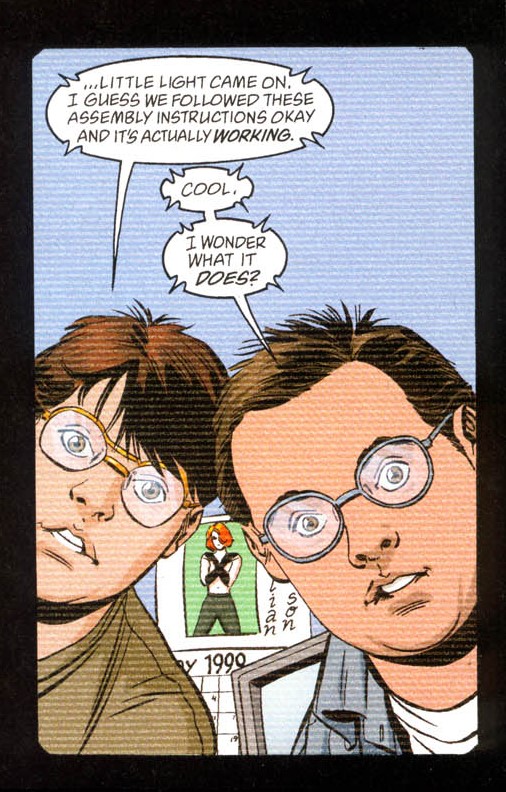 Later, Dahlua Strong, and King Solomon, are tending to a disabled jet airliner. They have it under control, so Tesla Strong takes their jump jet to attend to another distress call and radios Pneuman for details. He says that two students, named Funt, have reported that a science project has gone wrong. Tesla asks if they are calling for help with their homework and Pneuman replies that the line went dead, before he could get further details. Tesla nears Circus Avenue, where they live and radios back that she will investigate. What she finds requires a bit more than hooking up positive and negative terminals, on a battery....  Fortnum and Mason Funt downloaded plans from the internet, to create a robotic device, which turned around and fabricated another, which then did the same and the thing grew exponentially, until it encompassed the entire building. They have recreated the modular robotic system that Tom fought in 1987, which then fabricates a copy and joins with it, bosting both its intelligence and fabrication ability. As each new module is created, it joins with the others, engulfing the entire area for resources and energy. Tesla tells Pneuman to get help her way, as they are in trouble. Pneuman drives the roadster to pick up Dhalua and King Solomon at the airport, telling them of the return of the Modular Man. A reporter, covering the rescue of the airplane, relays the news to the public, as the Strong Family team take off. By the time they reach Circus Avenue, the Modular Man has grown to encompass a whole city block....  Tesla has rescued the Funts, but says to keep anything metal away from the Modular Man. As the car passes nearby, the wall bursts out and modules attack the car, disabling it and they begin consuming it and Pneuman. King Solomon gets Pneuman's legs detached, before they can get near his brain. They see the Modular Man come online...  The police want to evacuate the city, but Dhalua is concerned about her daughter, who is in harm's way. Tesla continues to get the Funts to safety and explains to them about the Modular Man. Scientist Temple Baldry discovered he was terminally ill, in the 1980s, and uploaded his consciousness into a robotic module, which was self replicating. As it created new units, his consciousness would grow and draw more power and resources and continue growing. When enough modules had been formed and joined, Baldry's personality would take over; effectively, he became immortal. The Strong Family put a stop to him in 1987 and thought his threat was over. Finally, Tom Strong arrives, from space, in the Hyper-Saucer. Tesla fills him in and he heads to the center building. he jumps off the saucer and fires his harpoon gun. He snares the building and finds his way inside. Modular Man speaks to him, saying he cannot stop him, while Tom says he has defeated him twice before. He comes to the "brain" of the entity.... 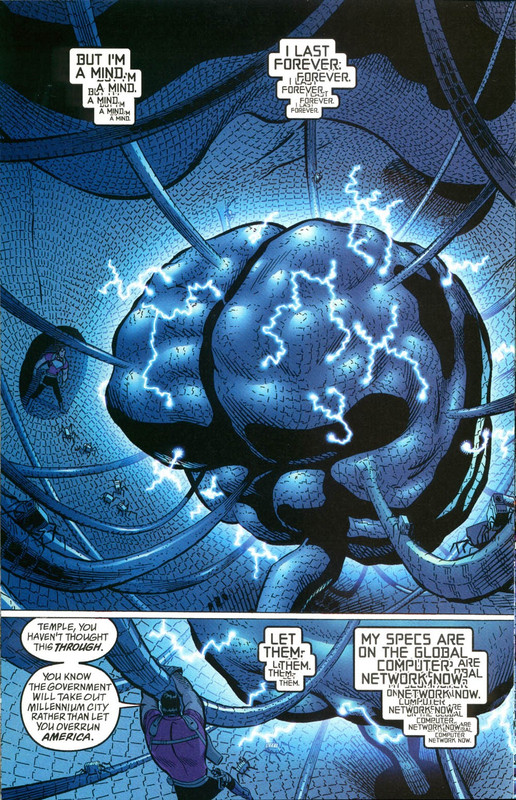 He reasons with Baldry, telling him that the government will destroy the city, rather than let Modular Man grow beyond, into the rest of America. he retorts that the specs are on the internet and are now global; so he can be reborn in multiple locations and multiply quickly, soon covering the Earth. Tom tells him he will just destroy him, again, when he pops up. They will go on like this, with brief periods of consciousness, until Tom tears it down again. He suggests an alternative. Baldry recognizes the logic of it and asks what he suggests. Outside, Tesla, Dhalua and the Funts witness the Modular Man contract from the buildings, opening a gap, from which Tom emerges. They watch as it unites with the Hyper-Saucer and flies into space. Tom explains he convinced Baldry to travel to Venus, where he can grow and live. Tom gathers up his family and heads home, to search the internet and remove the remaining data of the Modular Man, so it cannot replicate on Earth. Thoughts: This was a great story, mixing in modern nano-technology and old fashioned sci-fi stuff, into a sort of sci-fi pot pie. At the time, there was a lot of talk in scientific circles, about the potential of nano-technology to accomplish all kinds of wonders, from medical advances, to communications to even the creation of "nano-forges," which could break down matter into base components and then forge something new out of those resources. Modular Man is built on that premise. It combines things like the unrelenting Alien creatures, from Dan O'Bannon and Ron Shusett's script (which was inspired by The Thing From Another World, Forbidden Planet, and Planet of Vampires, among other things) with this idea of nano-forges, as well as The Borg and other hive-mind entities, into a threat for Tom Strong and his family. This is pretty much Fantastic Four kind of territory and Moore uses it to showcase the capabilities of the entire family, as Tesla, Dhalua, Pneuman and King Solomon all take part in this, well before Tom Strong returns to Earth and is able to reason with Temple Baldry's consciousness. We see that each member has their own set of strengths and contributes to the whole. Meanwhile, Moore adds a liberal dose of humor and characterization, with the Funt twins, Fortnum and Mason, constantly bickering and acting like internet geeks, vacillating between the scientific wonder and raging adolescent hormones, as they drool over Tesla and Dhalua. These are immature nitwits, with enough brain power to get them into serious trouble, but not enough maturity to extricate themselves. They will return as part of the Strongmen of America fan club, along with Timmy Turbo and future characters, to act as a sort of kid gang choir, for Tom Strong's adventures (though more Tesla, as she interacts more with them). These two chuckleheads even argue about which one is Fortnum and which is Mason! They are quite fun, despite being a bit overly stereotypical. They are meant to represent a kid gang archetype, with a modern framework. So, they will be a source of conflict within the group, due to their immaturity, and a source of humor, as their immaturity cancels out their brainpower. King Solomon and Pneuman are also a bickering pair, patterned largely after the two most popular members of Doc Savage's Famous Five, Lt Col Anthony Blodgett Mayfair, aka Monk, and Brigadier General Theodore Marley Brooks, aka Ham. The pair were constantly at each other's throats, launching put downs and insults, adding doses of humor to the Man of Bronze's adventures. The other three, Col John "Renny" Renwick, Maj Thomas "Long Tom" Roberts, and William Harper "Johnny" Littlejohn, tended to be a bit bland and underdeveloped, apart from an individual personality tic (such as Johnny's use of multi-syllabic words, like "superamalgamated"). Monky and Ham's constant battle of wits livens up some otherwise dull sections of the stories and helped make Doc Savage the number 2 pulp hero, behind The Shadow. We also get to see more of the family's advanced technology, including a VSTOL aircraft (the "jump-jet) and an intergalactic spacecraft (the Hyper-Saucer). So, again, a nice mix of adventure and humor, with some actual science in it. Given that so many comic book heroes were built around brawn or power, it was nice to see a return of a hero who uses their intelligence more than their fists, while still giving us cool technology. Tom Strong is a thinking man's hero, using reason, after brute force has failed to ultimately solve the problem. In that, he shares traits with characters like Doc Savage and Reed Richards, as well as other science heroes of science fiction, prose, comics and film. There was a time when our heroes were men and women celebrated for their brain power, rather than their firearms, ability to take a punch or to kick ass. Tom Strong was a welcome return of that archetype. Next, the debut of Promethea.
|
|
|
|
Post by codystarbuck on Oct 21, 2022 22:07:02 GMT -5
Promethea #1 Creative Team: Creative Team: Alan Moore-writer, John H Williams III-pencils, Mick Gray-inks, Todd Klein-letters, Digital Chameleon-colors, Scott Dunbier-editor Who names their kid Digital? Who were their parents, Occipital and Dorsal? Synopsis: In Alexandria, 411 AD, some beardy grumpy dude sends his little daughter out into the desert. to survive, before a group of evil Christian monks come and wave spears at him. he then taunts them until they stab him to death..... 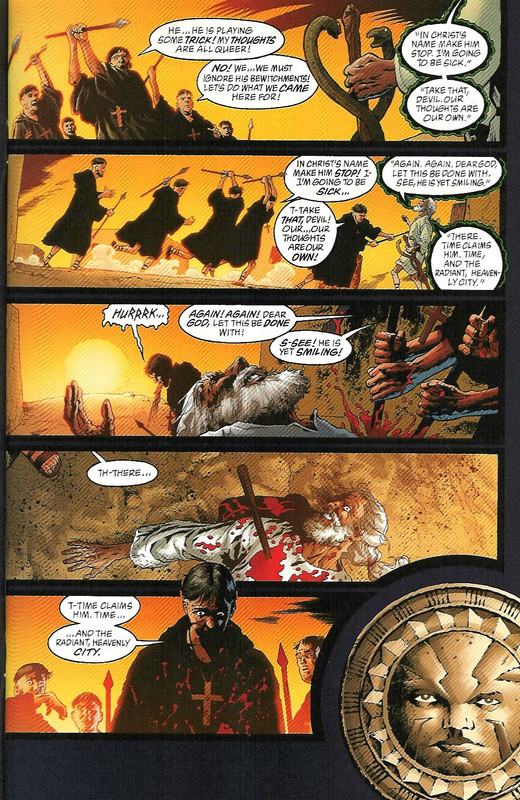 Nothing personal or metaphorical here! In a very different 1999 AD New York, two young women ride in a cab that hovers above the ground and flying saucers float overhead, zapping random people on top of buildings. A young woman, named Sophie, is off to interview a woman, named Barbara Shelley, who is the widow of the last guy to write about a woman, called Promethea. The name pops up in all kinds of places, from 18th Century poems, to 20th Century pulp novels and comics. Her fried Stacia makes fun of her and then has the cab drop her off, as she heads elsewhere. Sophie meets Mrs Shelley and explains the paper she is working on, about how this Promthea figure turns up as a fairy maiden, a hidden world pulp series, as Queen of a lost continent, and in a comic book, as a science hero. Barbara seems uninterested and gives her a could shoulder out the door... 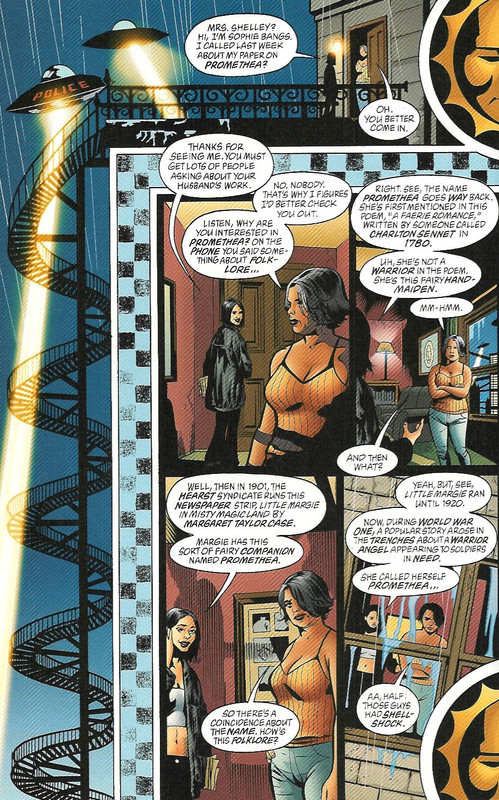  Back in 411, the little girl stumbles around the desert, calling out to her father about where are these gods who are supposed to look after her. Suddenly, a bright light fills the sky. Cut back to 1999 and Sophie is blinded by a light, coming from a floating platform, which carries The Five Swell Guys, a science hero team..... What, these guys? Oh, wait, that's the 5 Neat Guys. These are the swell guys... 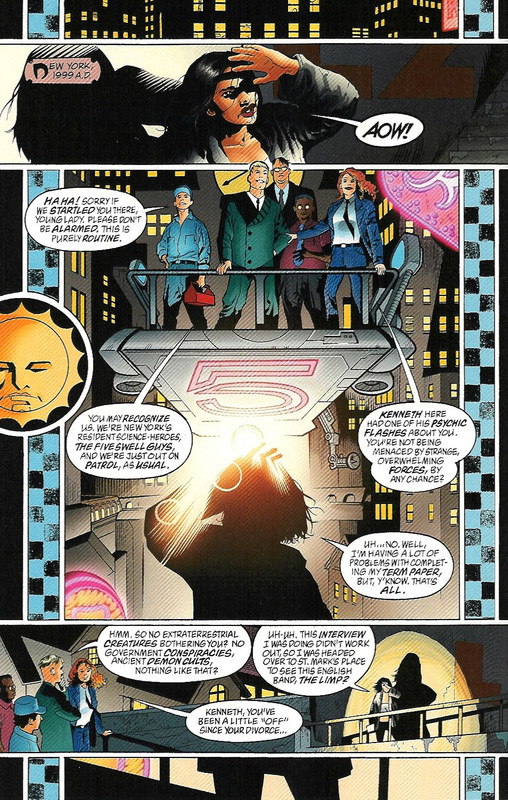 Sophie tells them that she isn't being menaced by extraterrestrial beings or supernatural figures or Amway salepeole and they go on their way. Sophie moves on her way and is followed by some kind of living shadow. Sophie senses someone and calls out and the shadow reaches out and puts a claw-y looking hand on her shoulder and Sophie runs, screaming. All of a sudden, some big gal comes swinging along and scoops her up and jumps up to catch the rail of an overhead bridge and tells Sophie to climb up. She then throws the shadow creature, which she calls Smee.....  ....into a truck, but it gets better. They run and hide inside a building and the Grownup Peppermint Patty says she is Promethea.... 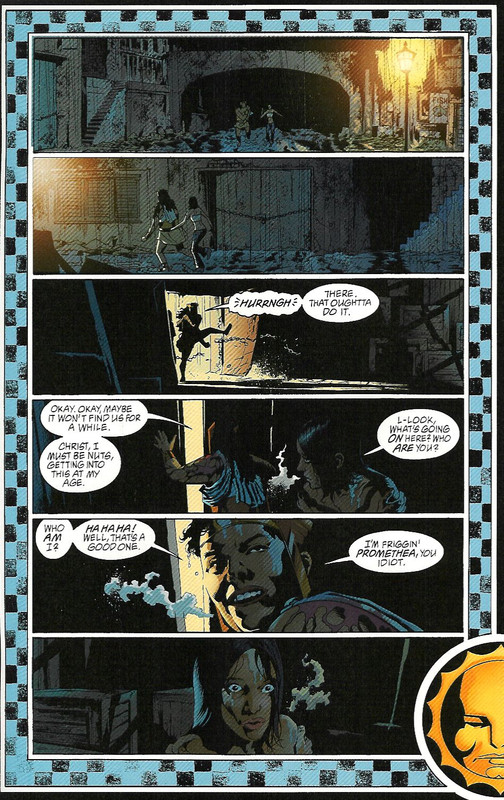 We cut back to 5th Century Alexandria, where the little girl meets Thoth & Hermes... 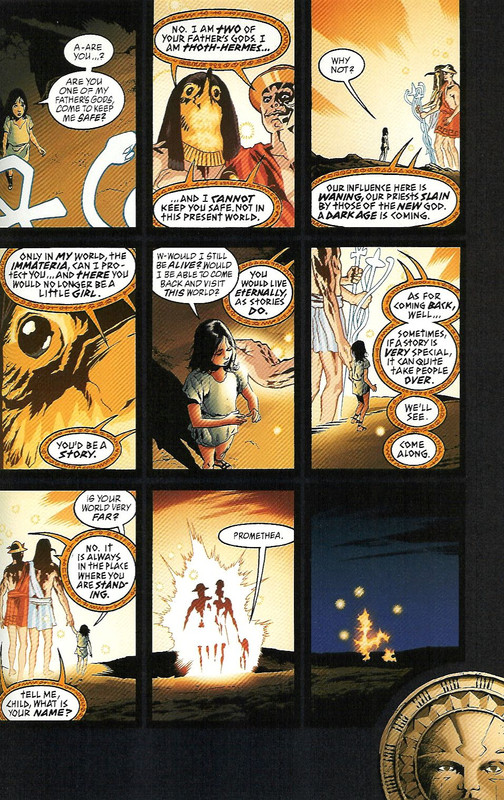 They take her to the Immateria, where she can live on as a story and maybe come back, if enough people are taken by here. She tells them her name is Promethea. Promethea explains to Sophie, how the story grew and was told by others and their enthusiasm for the story could bring Promethea to life, with the enthusiast or a loved one becoming Promethea. Margaret Case, who drew the early 20th Century cartoon became Promethea and aided wounded soldiers, in the trenches, in WW1, while Grace Brannagh, the cover illustrator of the pulp magazine stories took on the mantle in the 20s and 30s. This one is Barbara Shelley and she transforms back from Promthea into the Barbara form that Sophie met. Barbara says that Sophie is the next host for Promethea, judging by the Smee creature stalking her. She tells Sophie to find some place safe and quiet and write about Promethea: a poem, a description, anything. Sophie does as she is told. She writes and the words flow out, writing about Promethea and her origins, talk of her power and purpose. The Smee finds barbara who tries to persuade him that whoever sent him was wrong about Sophie; but, it isn't buying it. Then, the words transform Sophie and Promethea stands there.... 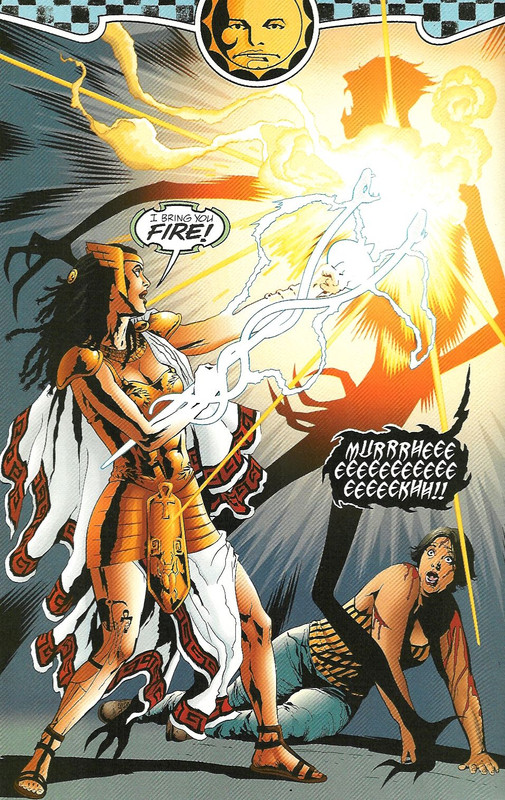 She drives off the Smee and destroys it with heavenly fire. She attends to barbara, who tries to tell her about her predecessors. She tells Barbara there will be time and takes her off to get medical treatment. Thoughts: So, Alan Moore kind of taking a page from Neil Gaiman, who had consulted with Moore and borrowed a script to learn to write comic book scripts, leading, ultimately to Sandman. The basic concept is nothing new, as many fantasy and science fiction stories have been created about belief in something or someone giving it physical form. In the abstract, that is how gods exist, as they are given form by their worshippers and grow in strength as their followers multiply and wane as their followers leave....or so the story goes. In essence, in mythological terms, people create stories, to explain their world, provide a metaphor for an event or concept and it takes on form in the imaginations of the listeners and grows into full on worship. As people and places change and new ideas come along, the worship dies out and the gods and heroes and monsters become just figures of myth. Within the study of mythology, myth means the stories told, rather than a comment on their veracity. When you read a lot of mythology, you find a lot of commonality in the stories told and the figures that are described. There is a history of "the people," how their world came to be, the rules given to the people for living in harmony and then tales which illustrate a point (parables). The figures within the stories may be different; but their roles and the events tend to fall along similar lines. Here, Moore is presenting a world where dreams, stories and myths exist in another realm and strong belief in them or what they represent can give them physical form. Sophie has researched Promethea and fallen under the spell, no matter how detached she tries to present herself. Why go to all of the trouble of digging up old poems and comic strips and pulp stories, unless something within them speaks to you? Barbara sends her off to tell the story that she sees and the telling acts as a ritual to bring Promethea from the Immateria to this world and inhabit the form of Sophie. She now takes on the mantle of this hero. Moore draws a parallel from Promethea to the Greek figure Prometheus, who steals fire from the gods and is punished by being chained to a rock and to have his innards torn out, every day, for eternity. In part, this is a sun myth, as it reflects the sun's journey across the sky, marking the progression of the day, to disappear (die) and return (be reborn) in the morning. Other sun myths of the Greeks refer to Apollo, flyig across the sky, in his fiery chariot. There is also a parallel to Wonder Woman, which was tied to the Amazons of myth, though Marston used the Roman version of the myths, due to his classical education, which was influenced by English traditions, which used the Roman myths brought to the British Isles. Moore mixes both Egyptian and Greek , in the form of Thoth and Hermes, as some kind of gestalt god; two forms united into one being. This sort of reflects the intermingling of the Mediterranean cultures, as the Greeks and Egyptians carried out commerce and influences, later joined by the Romans, who conquered Egypt and Judea. The setting in Alexandria, in the 5th Century, is deliberate, as it is a sort of crossroads of those cultures. Alexander conquered Egypt and founded the city of Alexandria, then the Ptolemaic Dynasty ruled in his succession, until the conquest of the Romans. This being Beardy McGrumpypants, this ancient wisdom is destroyed by Christians, who object to Promethea's father worshipping "devils." I'm an atheist and have no dog in that hunt; but, Muslims did similar things, the Romans did similar things, the Greeks....Conquering armies tended to crap over the conquered and often tried to replace the native culture with their own, right on up through the centuries. Whether or not Moore is specifically targeting Christians or using them because the time period is debatable. Christianity was the dominant form of Religion in the Roman Empire, by this point, though the Empire was crumbling. He may be making a point about evangelical zeal or just using a cliche. It is a bit tiresome, as other cultures and groups were just as, if not more intolerant and it seems like Moore is trying to bait Christian readers into attacking him, so he can then claim persecution. He did make a big deal about his Magick beliefs and snake-headed gods, in a way that suggested he was using it more as an attention device than actual spiritual practices; but, maybe I am too cynical. After reading several interviews with Moore (especially that long one, with George Khoury) and some video interviews, I get the impression that he likes to create a performance for the interviewer and says many things to provoke a reaction. Again, I may be overly cynical; but, I don't buy that he believes everything that comes out of his mouth. I think there is a definite performance art aspect to what he does, which goes along with his storytelling on paper. Promethea, as describe by Moore, in advance of publication, was supposed to be his most personal vision of his beliefs, both about stories and Magick Rituals. In the long Khoury interview, he describes his Magick practices as, basically, a kind of meditation, with a spell acting as a mantra. It isn't that he thinks the spell actually transforms things, but serves to focus the mind on a desired outcome, guiding the meditation, which is pretty much the purpose of a mantra, to focus the mind on the meditation and leave behind material concerns. Prayer can serve a similar function, in a Judeo-Christian, Islamic or similar tradition, or meditative practices in Buddhism and Hinduism. In the same way, a story gives focus to a concept, bring it "to life." Leaving behind the esoteric, we get the fairly common supernatural tale of an innocent pulled into a world with powerful, unseen forces and a mantle is thrust upon them. They must take it up and fight against evil. Standard archetype. Meanwhile, it would seem that this world is technologically advanced, relative to our own, matching similar things in both Tom Strong and the future Top Ten. It is a world of science heroes, as witnessed by the 5 Swell Guys. John H Williams III (need a comic by all of the 3s;John H Williams, John K Snyder, and Malcolm Jones) gives it a nice futuristic look; kind of typical sci-fi, but not quite as Herculean as Top Ten or classic Art Deco as Tom Strong. Moore understands the power of such design aesthetics and how they go hand in hand with comic book heroes. Cities need to be as epic as their heroes. Williams' characters have a life to them, rather than the more common generic look that many superhero artists bring. It's a more Vertigo approach to things, than a DCU, which shouldn't be too surprising. Promethea is probably the most "Vertigo" of the ABC Line. Tom Strong is more classically oriented, a bit more Old DC and Classic Golden Age material. Tomorrow Stories is a bit more of a mix of influences, with a little 2000 AD and other British comics, some Spirit and 1940s comics (including Plastic Man) and a bit of cheesecake eroticism, in the form of Cobweb. Top Ten is very Marvel (though also with certain DC elements). LOEG is very much a 2000 AD attitude, with hints of classic British comics, like The Eagle and some of the Boys' Papers. On the surface, this seems like a Wonder Woman pastiche, which is the way it came across, in 1999, in publicity; but, that is just the gloss. Just as Tom Strong is more than just Tarzan, Doc Savage and Superman, Promethea is more than a mythological superhero and Top 10 is more than a superhero police procedural. That is part of what made the ABC line a must-have. While the mainstream was largely regurgitating stories of 20, 40 and 60 years before, Moore went back to the foundations of the medium and gave us new takes on the archetypes, filtering in post-Modern ideas and alternate belief systems, and healthy doses of satire. The 5 Swell guys and the banter between Sophie and her friend Stacia is rather amusing and shows that you can do "serious" comics with a sense of humor. Next, we are back to Tom Strong, as LOEG had a long gap between issues Tom deals with Space Aztecs, so get your feathers and sacrifices ready.
|
|
|
|
Post by Calidore on Oct 22, 2022 8:31:03 GMT -5
Again, I may be overly cynical; but, I don't buy that he believes everything that comes out of his mouth. I think there is a definite performance art aspect to what he does, which goes along with his storytelling on paper. I'm with you there. That also seems part of Moore's need to turn every disagreement with a co-creator into a lifelong feud with himself as a victim of unspeakable perfidy. Re. performance art, I've wondered the same thing about Grant Morrison as well, how much of the metaphysical/conspiracy stuff he puts forth in his letter columns in The Invisibles, for example, he actually believes. |
|
|
|
Post by codystarbuck on Oct 22, 2022 10:55:07 GMT -5
Again, I may be overly cynical; but, I don't buy that he believes everything that comes out of his mouth. I think there is a definite performance art aspect to what he does, which goes along with his storytelling on paper. I'm with you there. That also seems part of Moore's need to turn every disagreement with a co-creator into a lifelong feud with himself as a victim of unspeakable perfidy. Re. performance art, I've wondered the same thing about Grant Morrison as well, how much of the metaphysical/conspiracy stuff he puts forth in his letter columns in The Invisibles, for example, he actually believes. I'm pretty much of the same opinion, there, in regards to Morrison. I definitely feel that both seem to like drawing attention, in an Alistair Crowley fashion. Neil Gaiman used to sort of give me that vibe, when he ran around dressed in black jeans and t-shirts and leather jackets and Raybans. Maybe he spent too much time as a music journalist. I've heard and read stories about Howard Chaykin, in the 70s, wearing fashionable suits to conventions and saying provocative things, which is kind of confirmed in The Art of Howard Chaykin, from Dynamite. Howie liked to provoke people, back then, though he seems to have mellowed, since he sobered up, in later years. Artists have egos and they wouldn't be the first to put on a facade, for public consumption. Kirby was one, though, who I always felt came across as "What you see is what you get," with no pretentions and no massive ego, to which he had every right, given his work over the decades. |
|
|
|
Post by Calidore on Oct 22, 2022 19:00:02 GMT -5
Kirby was one, though, who I always felt came across as "What you see is what you get," with no pretentions and no massive ego, to which he had every right, given his work over the decades.
Wouldn't surprise me if his WW2 military service, including dangerous advance scout duty, had a grounding effect. It's quite an interesting contrast that this regular guy/combat veteran on the outside had such a gigantic, no-holds-barred imagination on the inside.
|
|
|
|
Post by chaykinstevens on Oct 23, 2022 9:46:04 GMT -5
Creative Team: Alan Moore-writer, John H Williams III-pencils, Mick Gray-inks, Todd Klein-letters, Digital Chameleon-colors, Scott Dunbier-editor According to Wikipedia, Williams' first name is James. |
|
|
|
Post by mikelmidnight on Oct 24, 2022 11:31:27 GMT -5
On the surface, this seems like a Wonder Woman pastiche, which is the way it came across, in 1999, in publicity; but, that is just the gloss.
Although one of the past Prometheas was clearly a pastiche of the silly 60s Wonder Woman, the comparison I always made to the lead character in this series … myth-powered superheroine in short white dress who transforms and uses power through poetry … is clearly the mighty Isis.
|
|
|
|
Post by codystarbuck on Oct 25, 2022 21:54:21 GMT -5
Tom Strong #3 Tom vs Space Aztecs! Okay, technically those are Mayans, in the film. You try finding a movie about Aztecs! Well, one that doesn't involve lucha libre and mummies! Creative Team: Alan Moore-writer, Chris Sprouse-pencils, Al Gordon-inks, Todd Klein-letters, Tad Ehrlich-colors, Scott Dinbier-editor Synopsis: On some alternate Earth, some dude gets gutted like a fish, on an altar and his blood connects a circuit.....  It awakens Quetzacoatl-9, a sort of virtual feathered serpent god. The dude in the elaborate chapeau, known as Moctecuzoma (wel will just call him Moct), asks for the probability of success for his plan to invade another Earth and annex part of its territory. Wait, I thought the Aztecs were from Mexico, not Russia..... Quetz says have fun storming the castle and off Moct goes. Next thing you know, a ziggurat temple appears in Millennium City, which happens to be on a target Earth. Tom Strong goes to investigate. He uses sciencey devices to get inside and then passes judgement on the civilization, based on its architecture....  The Space Aztecs turn up on floating platforms and zap Tom with electric weapons. He wakes up strapped to the sacrificial altar. Moct gives hima history lesson. On his world, the Aztecs were radically more advanced than the Europeans and when they turned up to conquer them, they met Cortez with machine guns. They conquered North America then the rest of their Earth, then spread across to parallel worlds. Quetz is an artificially intelligent program, which exists in 2058 parallel dimensions, at once. He orders his techs to start the process of digitizing/destroying Tom. Tesla and King Solomon turn up to find more ziggurats and search for Tesla's missing father... 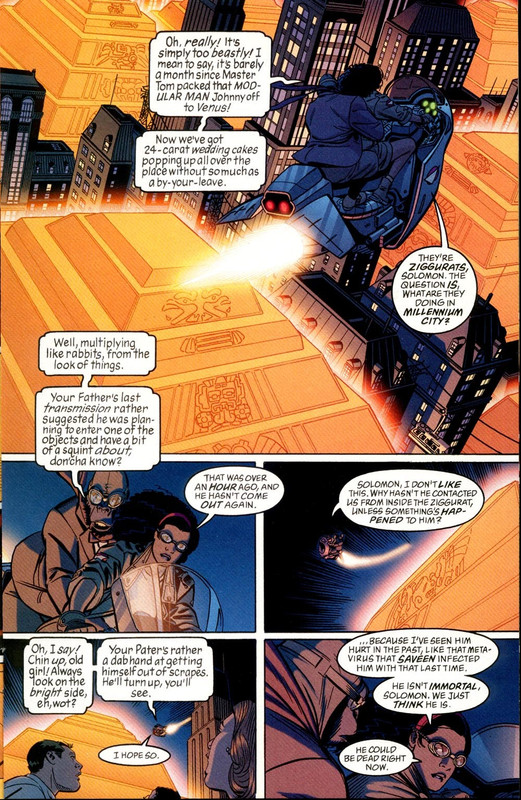 It turns out that tom is fine, inside. Quetz is faking his destruction with holograms, while he discusses what he wants, with Tom. He is kept in check by other programs; but, if Tom got to the master program and released him, then he really would be like a god. He directs Tom toward that end. Tom grabs a floater and then fights his way into the Palace of the Sun. Moct gets the alert and brings his troops with him. He vows to bring revenge on Tom, for what he has done. Tom takes him down a peg... 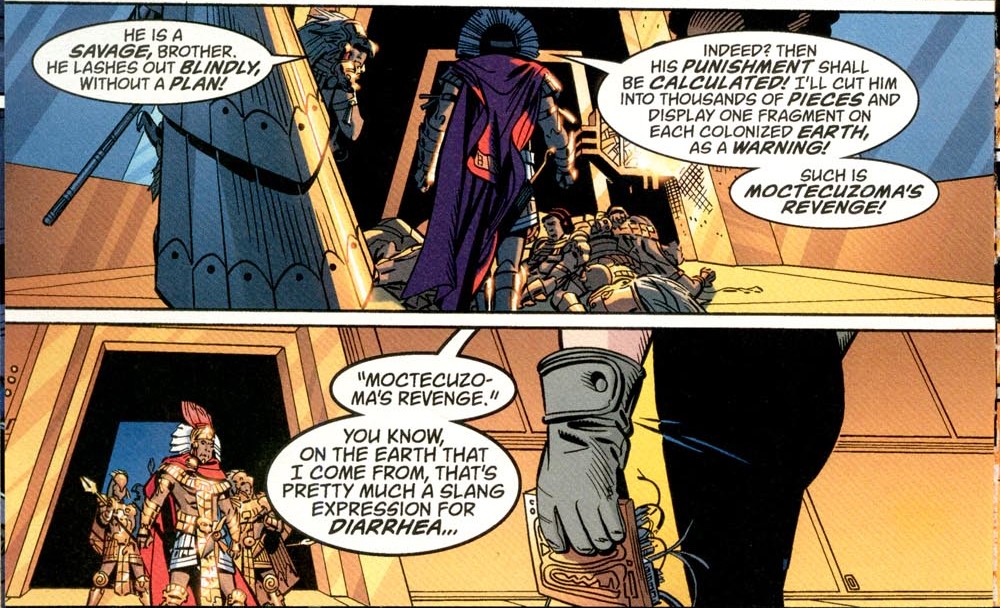 They are too late. Tom has severed the vital link of programming that held Quetz back. Quetz opens a digital can of whoop ass on the Aztecs. He then tells Tom what happens next...  Quetz decides that trusting Tom and vice versa was the best strategy to achieve his aims and he abides by his agreement to free Tom's Earth. he keeps the other worlds for himself. Tom emerges from the ziggurat and then they all disappear back to their world and Millennium City goes back to its art deco normal. Thoughts: This was an interesting issue, as I have always been fascinated by the advanced pre-Columbian Native American societies, like the Aztecs, Mayans, Taltecs and Incas, ever since I saw Kings of the Sun, on a Saturday afternoon tv broadcast. Moore takes the typical things people envision when you say Aztecs (if they know anything about the culture), then advances it into our future of technology. Then, he subverts our expectations, as Tom uses his brains to bargain with the artificial intelligence-turned-god. Based on the fact that he is depicted as a serpent and our own expectations of serpents, in myth, as well as the tone of how Quetz offers a bargain to Tom, we expect a double-cross. Instead, he abides by his bargain and demonstrates that he followed a logical course, as a computer program that gained intelligence might, given that logic drives the computer functions. Sprouse is in his element, with a mix of ancient architecture and advanced science, making this a sort of sci-fi archeology/anthropology. A lesser writer would have Space Aztecs be Space Aztecs; but, Moore makes them technologically based and undone by their own construct, showing that their tools have become self aware and want more than their programming. It all looks pretty darn cool. Next thing you know, they will go through a stargate and have a rumble with Space Egyptians. This is a big part of what I love about Tom Strong: Moore uses comic book and pulp tropes to set us up with an imagined conclusion, then he swerves us by doing something a bit more intelligent. It's not easy to tell, at the start; but, Moore is actually introducing various beings who will be revisited in bigger stories. Right now, he is giving us a feel for Tom and his family and some amazing beings he encounters, whose help he will need, down the road. This has the trappings of Silver Age adventure, but it is definitely a more post-Modern execution, in a novelistic approach. These little stand alone adventures are introductory chapters to a bigger saga, which Moore slowly builds. Up next, Moore introduces Teutonic Amazon Nazis, ala Airboy's Valkyrie (who was inspired by Terry Lee's Dragon Lady....or should that be Pat Ryan's Dragon Lady?), in a longer, multi-part story. Before that, however, we move on to the city of Neopolis and the officers of the Tenth Precinct. It ain't Barney Miller!
|
|
|
|
Post by codystarbuck on Oct 29, 2022 20:40:10 GMT -5
Top 10 #1 Those guys at the bottom are gonna be hurtin' when everyone above them comes crashing on top of them! Creative Team: Alan Moore-writer, Gen Ha-pencils, Zander Cannon-inks, Todd Klein-letters, Wildstorm FX-colors, Scott Dunbier-editor Synopsis: The captions tell us it is Monday, October 5, 1999, as a young woman rides a train to her new job. She looks a little punkish, like a college student or something. She is surrounded by ordinary people, on their way to work, or wherever the train is taking them. They come to a stop and most of the other passengers get off and a new crowd gets on, in colorful costumes, adult and child, male and female. They sound like they are doing every day things, talking sports and wanting to get prism capes, like all the other girls. Our new girl doesn't exactly blend in with the new crowd, but she didn't blend with the old, either. The train arrives in the city, Neopolis, which looks like the love child of Hugh Ferris, Fritz Lang and Ridley Scott, but everyone is dressed by Jack Kirby.  (The bridge is a Hugh Ferris design, from The Metropolis of Tomorrow), there is some Frank R Paul, just beyond the bridge, just left of center) Our young lady hails a cab, that looks like a mix between a Formula 1 racer, a taxi, and a guided missile. The driver, Bob "Blindshot" Booker uses Zen Senses to navigate to the police precinct; but, judging by the number of near misses he has and the accidents he causes trying to avoid him (including a Raymond Loewy streamlined train engine, which is carrying dry cleaning), he could use some help from more corporeal senses. He gets her to the precinct house and the young lady introduces herself, Robyn Slinger, to one of the cops, Jackie Kowalski. Robyn is fresh from the police academy. Jackie is decked out in bodysuit and leather tailcoat. The sergeant at the desk looks like a cross between a luchador and a weather map. A mural in the background looks like a Kirby. Jackie shows Robyn around and we see a lot of activity. She takes her to Captain Jetman's office and introduces her to the head of the 10th Precinct and Sgt Kemlo Caesar, a doberman pinscher who walks upright and wears human clothes. And can talk! Jetman says he knew Robyn's father, a cop called Colonel Lilliput. Sgt Caesar takes Robyn to the morning briefing and Jackie says they can catch up for a beer, after work. They go into the briefing room and the sarge introduces Roby, then gets on with the morning briefing... 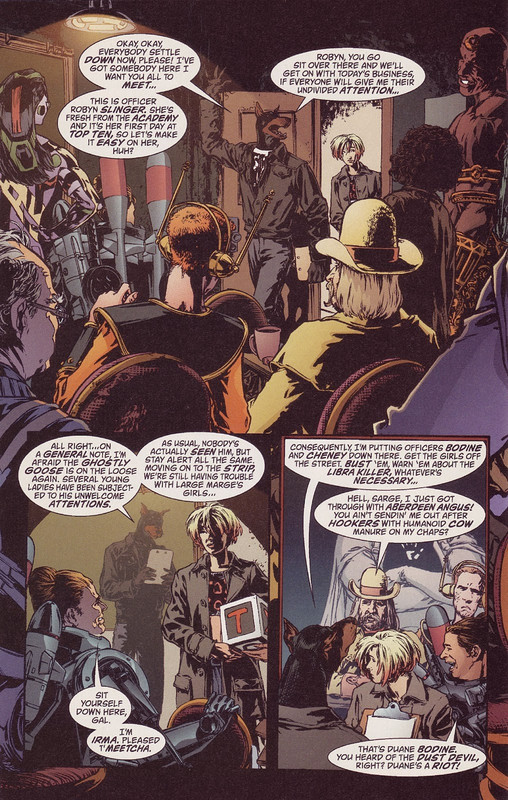 They have a serial killer, called the Libra Killer, running loose, some unseen figure molesting women, a homicide in "Tintown" and the usual stuff. Robyn meets Irma, aka Irma Geddon, who is decked out in armor and weapons, Dunae Bodine, aka Dust Devil, in cowboy gear, detectives Corbeau (in peacock feathers) and Jackson (in street clothes) and officer Cheney, who has all kinds of tubes and antenna on his head. Robyn is paired up with officer Jeff Smax, a big muscular guy in blue....right down to his skin. He seems thrilled to have a partner. They go to the garage and grab a squad car (based on the police "spinner," in Blade Runner) and head out on patrol. Robyn tries to make small talk, about the city being the dream of ex-Nazi scientists and science villains, after WW2; but, Smax isn't interested in history. They receive a domestic dispute call and head to the address. They are directed to the second floor, where Mr and Mrs Incredible are fighting again. A bystander says her youngest child has hyper-hearing and heard Mr Incredible say he was going to kill Shirley, aka Mrs Incredible. The door is barred and Mr Incredible won't open it, so Smax uses his talents..... 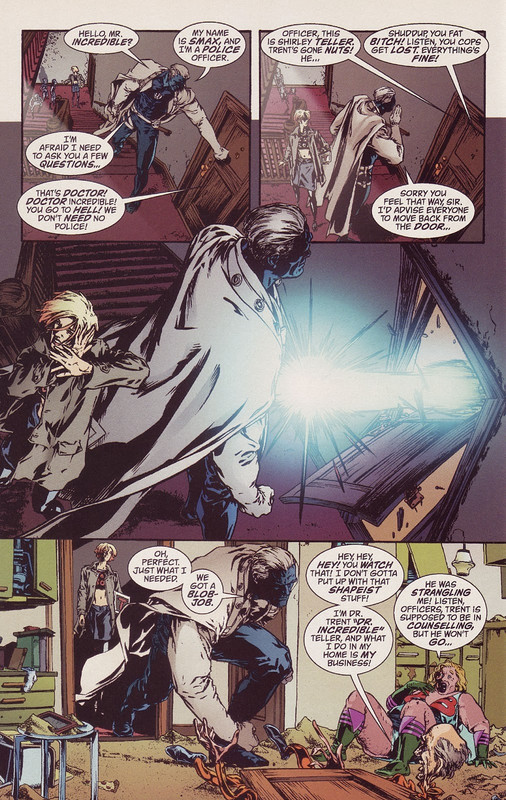 They pull Mr Incredible out, but Mrs won't press charges. He promises to go back to counseling, like he is supposed to. Smax and Slinger receive a call to help provide crowd control in Tintown, where Synaethesia is conducting an investigation (that's Detective Jackson). They drive over and get briefed by Detective Corbeau, aka King Peacock. We see robots, cyborgs and other emchanicals in a crowd of onlookers. One of them accuses Slinger of trying to pin the murder on "Ferro-Americans). One robot looks suspiciously like Woody Allen, in Sleeper, disguised as an android. Synaethesia sense colors and other impulses, but the crowd is overwhelming things. They need to widen their search of the area and Robyn opens up her toybox and lets her toys do the job. The corpse is identified as Steffan "Boots" Graczik. He has a matchbook with a phone number written on it. The toys find a high tech rocket "saddle," which belonged to the deceased. Back at the station, Dust Devil and Shock-head Pete (Officer Cheney) bring in a pair of hookers, who snarl that Large Marge will have them out on bail, in an hour. Irma Geddon and Girl 1, aka Sung Li, bring in one Ernesto Gograh (son of the 1950s monster) for suspicion of assault and battery, during a gang fight and parole violations. Irma takes Robyn to the cafeteria for lunch and a coffee, while Smax brushes her off. They talk about Smax and his late partner, "Stochastic Fats" Beaumont, who died in the line of duty. Smax took it hard and pulled a bar down on himself, though he is pretty much invulnerable. Kemlo turns up and tells Irma and Sung Li, as well as Robyn, that Captain Traynor (Jetman) wants them in the squad room. They find Captain Traynor speaking to Commissioner Ultima, who is in a parallel dimension, overseeing police in several realities. Traynor briefs them that the dead man, Graczik, was a runner for a drug ring, usually operating with a 14 year-old girl, named Marta "Boots" Wesson. The phone number is for a warehouse that is suspected to be used for the manufacture of illegal drugs and potions, including Amazo Pills, Hyperdrine, Mongoose Blood and other illicit things. The murder gives them probably cause for a raid and the assembled officers will be in on it. They meet up outside the warehouse and report to Bill Bailey, aka Wolfspider, the SWAT team leader. Corbeau and Jackson are in charge of the raid. They hit the warehouse in front and back and various thugs try to stop them from reaching "the professor." Robyn gets down to him and finds a small bearded man, with a beaker in one hand and a gun in the other. Her toys take him down and Girl-1 arrives to back her up, only to find that Robyn has cornered the infamous Professor Gromolko. They haul him in and Robyn receives kudos for her arrest. At the station, Robyn and Dust Devil are brought in for Gromolko's interrogation, which is to be conducted by Alexei "Space Man" Glushko. Large Marge (a 10 ft or taller woman, dressed like a brothel madame from the Old West) is there to bail out her girls, while a citizen reports an assault by the Ghostly Goose. Gromolko is in the interrogation room, with his lawyer, Mr Frenzy, as shark! Glushko comes in and Frenzy starts ranting about telepathic interrogation being inadmissible. Glushko makes Gromolko uneasy and he lets out unguarded thoughts.... 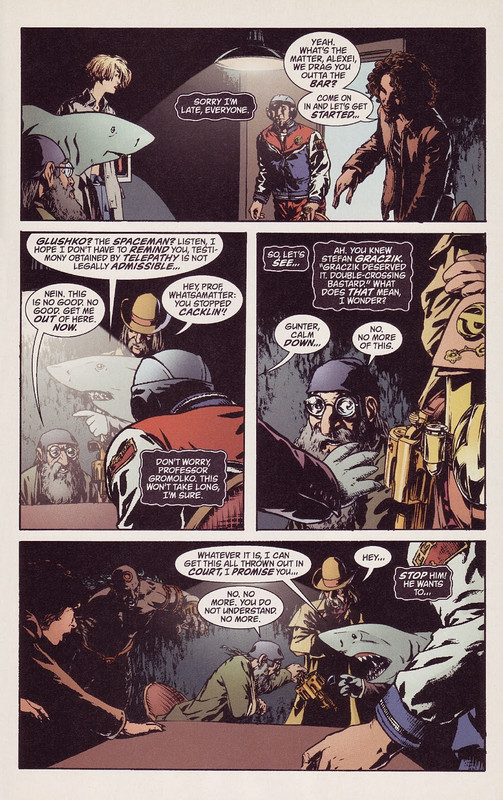 Gromolko grabs Dust Devil's Twelve-shooter and blows his own head off. While they get the mess cleaned up, Robyn is dismissed and she joins Jackie for that beer, though Pete Cheney makes some crack about Jackie "moving fast." They go to a bar and Robyn fills in Jack Phantom (Jackie Kowalski) about what happened. Jackie calls Smax a pig and says she wouldn't go for him, even if she were "straight." She gets another round and Robyn says she will need to get home soon, that a man is waiting for her. She seems uneasy and Jackie tells her "can't blame a girl for trying." Later, Robyn takes the train home to the suburbs, where her father is sitting, watching tv, without acknowledging her. it seems clear that he has some form of dementia. Thoughts: Great first issue that throws a lot of stuff at you, but also immerses you in the world of Neopolis. It is a megacity, the product of ex-Nazis and mad scientists, who built a city for superbeings and other amazing creatures. Everyone is either a superhero, supercriminal or other oddity, from massive reptile monsters to blind cab drivers. Gromolko was one of the architects of the city and his death means something bigger is going on. This world has drugs which give super powers, temporarily and cops with super powers. The basic structure is a police procedural and this issue uses Robyn Slinger, aka Toybox, as our POV character, as she experiences her first day on the job. She asks the questions for us, as she navigates her way. The characters all get little snippets, which, along with the visuals, give them character traits. Jeff Smax is the big blue guy, grouchy and stand-offish, but near invulnerable and super strong, with his blue light thing. Girl One is an artificial construct, given life by a pair of boy geniuses. Irma Woronov, aka Irma Geddon, is a fun loving, street smart cop. Synaethesia is able to read colors and sensations that others cannot. Shock-headed Peter Cheney is young and offensive and gives off static charges. His partner is Duane "Dust Devil" Bodine, a super-cowboy. King Peacock (Detective Corbeau) is a devil worshipper. Jackie "Jack Phantom" Kowalski is gay. Alexei Glushko is a telepath and he was inside Gromolko's head, when he shot himself. It seems Glushko has experienced a lot of trauma because of his skills. Captain Traynor, aka Jetman (formerly Jetlad), is a veteran, respected by all. he is a former boy adventurer/pilot, who has been on the force, since its inception. he's a legend and Robyn is in awe. her father, Col Lilliput served with him, but age has taken its toll, on him. We see that this world has neighborhoods and attitudes. Tintown is where mechanical beings live and it appears to be an adversarial relationship with much of the rest of the city. It's a ghetto and they are an oppressed minority. Later, we will see that people call them "clickers," as a racial slur. There are a lot of in jokes here, from street signs and logos to graffiti (I have a giant size man-thing, call 555-....) to buildings and background easter eggs. Jetman is a tribute to Airboy. Mr and Mrs Incredible are thinly disguised pastiches of Reed and Sue Richards. He rants about her lover, Prince Pyron. She turns to sand and used to be called Beach Bunny, but has put on a few pounds, over the years. This is Reed and Sue, if jealousy had pushed their marriage into physical abuse. Sadly, the scenes mirror many domestic dispute calls, where the victim refuses to press charges, after the cops are ready to haul away the abuser. All of this, leaving aside super powers and costumes, feels "true." It could be a police comic, if anyone bought them, without superheroes. Moore just uses the market trends to do that type of story, in a way that will grab a modern comic audience. Gen Ha and Zander Cannon do an amazing job here, making the characters look heroic or sinister, fitting in sight gags and some great design work. This series and the Times Past stories of Starman made me a huge Gene Ha fan. Cannon is the creator of the indie favorite The Replacement God and is a dab hand with the comedy. He later gets to do pencils on a Smax solo mini. The cover uses Alex Ross to ensnare people and get them to look at the insides, where Ha and Cannon dazzle. Moore just throws concepts and characters at us, in this world that is a microcosm of comic tropes, influences and trappings. Imagine an Ed Mcbain novel, illustrated by Neal Adams and that is Top Ten. Meanwhile, there are some mysteries going on here. Who is the Libra Killer? Who killed Steffan "Saddles" Graczik and how is Professor Gromolko tied in? Why did he kill himself if nothing Glushko learned can be used in court? What did he fear so much being known? Who or what is this Ghostly Goose who seems to molest women by goosing them or pinching their bottoms? It sounds harmless, but they do feel violated, by some unseen person or thing. We will get to savor these mysteries, for a bit. The easter eggs aren't as widespread as they will become, but, we see them in buildings, in things like the Sleeper easter egg, Pete Cheney types on a machine that is the head of the Robot (Robbie the Robot) from Forbidden Planet. The mother on the train, at the beginning, with the super child, is dressed like a take off of the Black Canary. Lawyers are real "sharks!" Talking police dogs. Son of Godzilla street gang punks! This is awesome stuff! Next up, Promethea is back for her second issue.
|
|
|
|
Post by codystarbuck on Nov 2, 2022 18:30:41 GMT -5
Promethea #2 Creative Team: Creative Team: Alan Moore-writer, JH Williams III-pencils, Mick Gray-inks, Todd Klein-letters, Wildstorm FX-colors, Scott Dunbier-editor Synopsis: Promethea gets Barbara Shelly to a hospital, while she tries to explain what Sophie is experiencing and warning her that there are worse things out there than the Smee. meanwhile, somewhere else, a man named Mr Solomon, who represents "The Temple," has hired two specialists to eliminate Sophie and the Promethea spirit that inhabits her.... 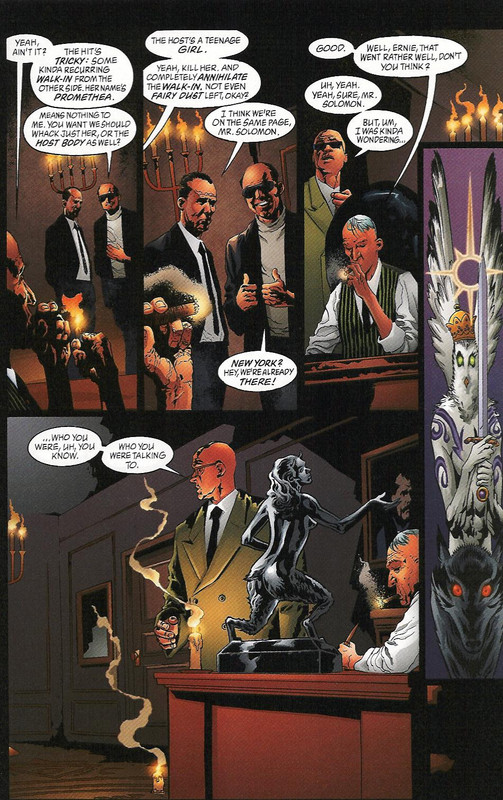 Sophie/Promethea calls Stacia and tells her to meet her out back of the club she is in. Stacia believes Sophie is miles away, but Promethea appears momentarily and Stacia starts to run and scream, but Sophie quiets her down and tries to xplain what;s happened. She says she doesn't know how to close the storybook, before the part about the wolf. Elsewhere, our two hit men are tracking Promethea and find her signature on the phone she used, by the hospital. They hail a cab and follow the trace. The cabbie recognizes them as "underworld types," which makes one giggle. he says he knows the cabbie's type and then repeats the sounds of the cabbie's grandchild protesting that he is hurting them. The child is 6 years old. When they arrive, they tell the cabbie that they don't have cash but hand him a gun and tell him to do the right thing. he shoots himself in the head, as they leave. Stacia and Promethea go inside the club and the two hoods turn up and get past the doorman. Promthea spots them for the demons they are. They appear as a wolf and a bull and are from the Goetia....  The hoods find out that Promethea is not a "walk-in," a spirit guide; not a goddess, either. She is something more, something more powerful....imagination made real. Her power is beyond theirs. Some kind of portal opens and the creatures depart. Stacia gets sucked into the vortex behind them. Promethea yells for her to grab the caduceus, but it is too late. 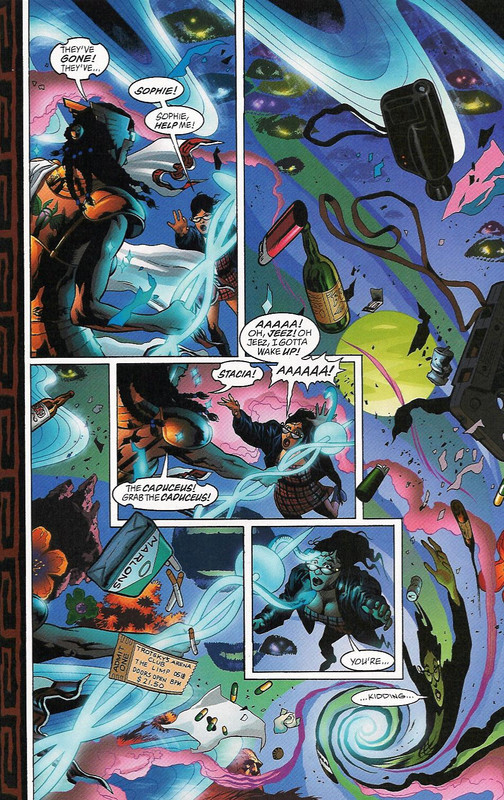 Thoughts: Thoughts: Well, that moved by rather quickly. Sophie is grappling with what and who she has become, while Barbara tries to warn her of worse threats than a Smee. She tries to talk to Stacia, to make sense of things and they are attacked by hired demons, representing "The Temple," who are out to destroy her. However, they underestimate the strength of Promethea, but she pays a price for inexperience, as Stacia is sucked into whatever dimension they entered. The demons' conversation with Solomon is done in the style of gangland hoods, but with supernatural overtones and talk of rising to higher circles. This is a real "underworld." Much of this reminds me of Matt Wagner's Mage. Kevin Matchstick, an ordinary guy (with a dumb surname) runs into a street magician, who helps save him from some weird creature. It turns out that Kevin is Arthur, reborn and the magician is Merlin, or a version of him. They meet a woman, who drives an Edsel, who is one of Arthur's knights, whose bat is enchanted with power. They have to stop the evil forces from destroying the Fisher King. Edsel is killed and Kevin takes up her bat, which transforms from a green glow to white, as Excalibur has found its true master. Same kind of thing going, here. Sophie gives new form to the idea of Promethea, but her studies of Promethea and her enthusiasm for the project have given powerful shape to the ideal. The forces of evil send killers, but are outclassed. Promthea loses a friend in the battle, before she truly knows what she can do. It's not a new story, as it follows the conventions of the heroic journey, as outlined by Joseph Campbell, in the seminal Hero With a Thousand Faces. The hero is often hidden away and is revealed. They have to undergo a journey to gain power, wisdom, or allies. The forces pitted against them hunt them and friends may be sacrificed in the battle. Lot or archetypal stuff going on here. Visually, it is stunning, as Williams and Gray hit us with powerful and weird images, while also making it accessible and human. The backgrounds are filled with huge buildings and levels to the city, much like Neopolis in Top 10 and Millennium City, in Tom Strong. Moore seems to be fixated on the idea of epic cities, with layers, which may reflect the influence of Mega City One, in Judge Dredd or Fritz Lang's Metropolis, which has haunted urban visions, since its debut; or, just reflect the evolution of London and other large cities. Since the 1980s, London had been undergoing sweeping changes in its skyline and development of old areas, such as the Docklands. It came with much gentrification and controversy as part of the battles between people and profit, under the Conservative government, which continued when Labour came to power, under Tony Blair, as witnessed by the Millennium Dome project, and with successive governments, with the Olympics. We are still very much in the expository phase of things, so a lot gets thrown at us and we don't see much character development yet, other than seeing Sophie talk about Promethea's voice within her and the dichotomy of her new existence. If Moore sticks to form, we will get a bit more of this opening phase, before he really starts working on the characters and moves into the central plot. Next, Alan brings along some friends to play in this world, as we see the debut of the anthology, Tomorrow Stories.
|
|
|
|
Post by codystarbuck on Nov 6, 2022 22:09:02 GMT -5
Tomorrow Stories #1 Creative Teams: Creative Teams: Alan Moore-writer, Kevin Nowlan-art, letters & colors (Jack B Quick), Rick Veitch-art (Greyshirt), Jim Baikie-art (First American), Melinda Gebbie-art (Cobweb), Todd Klein-letters(everything except JBQ), Wildstorm FX-colors (except JBQ), Scott Dunbier-editor. Synopsis: Jack B Quick- Out in Queerwater, young boy genius Jonathan Beauregarde Quick (Jack to his friends) lives on a farm, with his parents, where he and his father observe their cow Bessie, being overcome by Night-Fits. Pa says they will have to shoot her; but, Jack thinks he can save her. He finds a loophole in Einstein's Theory of Relatively and takes his mother's vacuum cleaner and some radio parts and builds a Quantum Vacuum Cleaner, which creates a Big Bang, which results in a new sun, just above Bessie's corral, complete with 4 new planets, some comets and a lot of interruptions, for the townsfolf.... 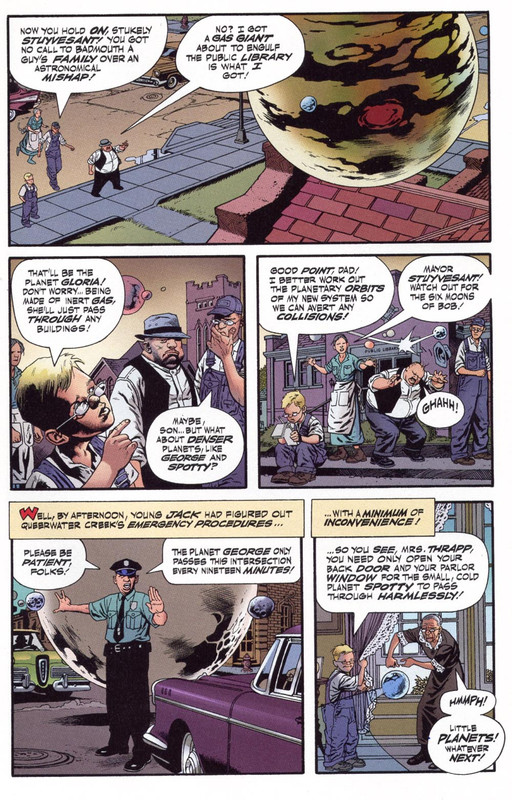 Just as things eem to settle in, the sun starts to turn into a red giant, then collapses into a black hole, sucking in all of the planets (Bob, George, Roy, and Gloria, the gas giant) and then Bessie. Bessie gets stretch and engulfed, except her hind quarters, which plugs up the black hole, leaving her back end to hover above the ground for eternity. jack theorizes they could still milk her, though she would only produce x-rays. he wonders if you could churn them to create see-through butter. Greyshirt- A man stands over a woman, with blood on his hands. There is a hammer nearby. He knows the woman screamed, but he can't remember a thing.... 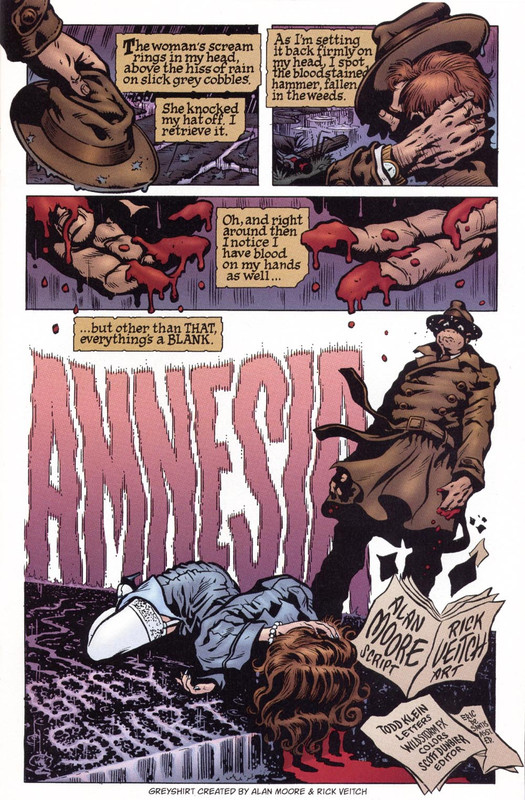 Newspapers are strewn on the ground. They speak of a Hamemr Killer, who is hunted by the hero, Greyshirt. The man realizes he must be the Hammer Killer, but he has no memory of it. He goes into a bar to lay low and think. He ponders whether he has multiple personality disorder or if he had trouble communicating with women, which might have twisted his view of them. A beautiful woman enters and stands next ot him, at the bar and orders. She pulls out a cigarette and asks for a light. He starts yelling at her about amnesia and killers and is kicked out of the bar. He tries to hide inside a move theater, which is showing a murder thriller. Police enter and start asking the audience questions and the man runs out, with the police and Greyshirt following him, telling him he might as well stop, as they know everything. He tries to hide inside a gas company and comes across a night watchman, eating his dinner. Greyshirt follows him and finds him and he says he is the Hammer Killer. Greyshirt is stunned and says, no, they have the killer. The blood on the hammer wasn't the woman's, it was the victim...the amnesiac man. However, it is no comfort as he has killed the night watchman, thinking "What is another murder?" The First American- The First American and his sidekick, US Angel are battling Gert Dammerung, who is about to explode her Wagnerian Bomb, to put an end to the world's misery. The heroic pair stop her and she talks about how the Jury Swinger Show, brought her to the depths of humanity and she saw no future for mankind. The patriotic pair go to check out the show, but soon find themselves targeted by Jury and his depraved audience....  They are driven away and regroup, but US Angel is under Jury's spell, calling First American a monster and saying how she must have repressed the memories of his abuse. FA smacks her and she comes out of it. They go back on the attack and rip off Jury's face, to reveal an alien, but he just wants to enslave the Earth and asks what is wrong with that? The audience says nothing and FA and US Angel retreat to a bar, where they meet up with Gerta and tell her she might have a point. The Cobweb- Wealthy debutante Laurel Lakeland is in her stately pagoda home, reading about how four debutantes have fallen into coma's, caused by some unknown force. She tells her chauffeur Clarice to bring her limousine. She dons her Cobweb costume (Rowwwrrrrrrrr.....) and the head over to see the mother of Ivana Mantabilk, one of the victims.....  Ivana is comatose and the mother speaks of letters from a Dr Phallocrates Phlange, PHd. They go to see him. he seems a depraved maniac and he turns a ray on her, transferring her consciousness into a doll. He captures her and puts her in a dollhouse, with Ivana and the others, where he forces them to do depraved things, with teddy bears, GI Joe dolls and trolls. There is even a dungeon to punish those who refuse him. Cobweb helps the women escape and knocks down the doctor and turns his ray on him, then restores the others to their bodies. Thoughts: Jack B Quick is probably the best conceived of all of the segments, a parody of boy genius stories, complete with the cosmic lifecycle of a day. Jack's father seems possessed of some knowledge, while his mother is filled with common sense. Jack, on the other hand, dives into science like a child into a birthday cake and ice cream, with expected chaos following. It seems that everyone in the area gets used to his experiments going massively haywire and interrupting their lives; but, they adapt quickly. Nowlan's art gives this a nice deadpan quality that helps sell the jokes. Greyshirt is a pastiche of the Spirit, with a bit darker tone, but tongue in cheek. The ending is a nice twist on an amnesiac killer, as he turns out to be the intended victim of the real hammer Killer, the woman. However, her blow pretty much does kill the man he was. Veitch does his best Eisner immitation, though he ends up looking more like William Messner-Loebs, in the finished product, though Loebs was an Eisner devotee. First American is a big satire and commentary on the lowest common denominator nature of Jerry Springer and similar talk shows, designed to wallow in the worst of human nature. You can add later sludge, like Dr Phil and Oprah's parade of "experts," whose qualifications seemed to have been they wrote a book and held high priced seminars, before turning themselves to nasty politics. Anyway, Moore and Baikie capture the flavor of the show very well. The First American and US Angel have a sort of Adam West & Burt Ward quality, which makes the satire even funnier. Gerta Dammerung is a terrific name. Cobweb is Moore and his significant other, Melinda Gebbie, playing at a semi-erotic heroine, who dresses like a cross between Bettie Page and Phantom lady, while her adventures pretty much tread the world of erotic tease. Her it is objectification, as the debutantes are literally transformed into objects for the mad doctor's play. There is suggestion throughout, right down to the implication that Cobweb and Clarice may have more than a professional relationship, though it is vague enough that you read your own ideas into it. That is pretty much the work of "tease." The whole doll thing reminds me of a rather unsettling children's storybook we had, at B&N, called The Lonely Doll, by Dare Wright. It was the first in a series of photo storybooks with the character, Edith and they are creepy as hell. Wright was a former model, who took up photography and the books express her childhood trauma of loneliness and her domineering mother. You can read more about Dare Wright and the books here...Anyway, the Dare Wright books have an erotic undercurrent, whioch is part of what makes them unsettling, not to mention they have a rather dark tone to them. Melinda Gebbie has Cobweb sucked into a similar monochrome world....  When Ivana speaks of being forced to pose with teddy bears and GI Joe dolls, I am fairly certain that Gebbie was familiar with Dare Wright, possible Moore, too. The books have a cult female audience, who saw them in childhood, particularly in the late 50s and 60s and they have several fans in the art and fashion world, including Vera Wang. Gebbie would be a pretty strong candidate to be among them. So, there is quite a variety of material here, though the unifying theme is that the stories are satires and pastiches, poking fun at their various subjects, within a superhero or sci-fi adventure premise. The series would prove to be controversial, as DC pulled a story from issue #8, which had statements about Scientology founder and con-man L Ron Hubbard, even after vetting it and making changes, suggested by DC's legal department. Pretty much everything else from ABC is straight-forward adventure, with comedic moments (some more than others); but, this was pure satire, with adventure trappings. I don't know about sales for the line; but, it always seemed, anecdotally, that this was the least popular of the ABC books; or, alternatively, the one with the most cult audience. Next, Top 10 returns.
|
|









































